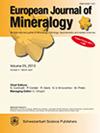One-atmosphere high-temperature CO–CO2–SO2 gas-mixing furnace: design, operation, and applications
IF 1.7
3区 地球科学
Q2 MINERALOGY
引用次数: 0
Abstract
Abstract. In this paper, we present a new design for a 1 atm gas-mixing furnace using the gas mixture CO–CO2–SO2. This furnace can simulate disequilibrium processes such as magmatic and volcanic degassing. Here, we present the technical aspects of the design. The furnace can sustain temperatures of up to 1650 ∘C and has a hot zone that spans 200 mm vertically, where the hotspot is determined to be ∼ 32 mm below the midpoint of the furnace enclosure. The four mass flow controllers are individually calibrated and accurate to within 0.8 % of the specified value. The fO2 is accurately reproduced in the furnace within ±0.002 log units, as calibrated by the Fe–FeO reaction across the iron–wüstite (IW) buffer at 1300 ∘C. The furnace can reliably simulate dynamic conditions, where the fO2 can be modulated at a maximum rate of 2.0 log units min−1 by varying the gas mixture. A delay of 40 s is observed to attain the fO2 calculated from the gas mixture, at the hotspot. A series of safety measures to protect the user from exposure to the toxic gases are detailed. In our experiments, the furnace is used to determine sulfur isotope fractionation factors among melt, sulfide, and the gas phase, within a magmatic context, using either crystals of olivine or silica glass tubes. The furnace has the potential to investigate various other dynamic high-temperature reactions occurring on Earth.单气氛高温CO–CO2–SO2气体混合炉的设计、运行和应用
摘要本文介绍了一种采用CO-CO2-SO2混合气体的1atm气体混合炉的新设计。这个熔炉可以模拟岩浆和火山脱气等不平衡过程。在这里,我们将介绍该设计的技术方面。该炉可承受1650°C的温度,并有一个垂直跨越200毫米的热区,其中热点被确定在炉壳中点以下32毫米处。四个质量流量控制器单独校准,精确到规定值的0.8%以内。在1300°C下,通过铁-钨(IW)缓冲层上的Fe-FeO反应,在±0.002 log单位的范围内精确地再现了fO2。该炉可以可靠地模拟动态条件,其中fO2可以通过改变气体混合物以最大2.0 log单位min - 1的速率调制。在热点处,观测到延迟40 s以获得由气体混合物计算的fO2。一系列的安全措施,以保护用户免受接触有毒气体是详细的。在我们的实验中,该炉被用来确定熔体、硫化物和气相之间的硫同位素分馏因素,在岩浆环境中,使用橄榄石晶体或硅玻璃管。该熔炉具有研究地球上发生的各种其他动态高温反应的潜力。
本文章由计算机程序翻译,如有差异,请以英文原文为准。
求助全文
约1分钟内获得全文
求助全文
来源期刊
CiteScore
2.80
自引率
9.50%
发文量
40
审稿时长
6-12 weeks
期刊介绍:
EJM was founded to reach a large audience on an international scale and also for achieving closer cooperation of European countries in the publication of scientific results. The founding societies have set themselves the task of publishing a journal of the highest standard open to all scientists performing mineralogical research in the widest sense of the term, all over the world. Contributions will therefore be published primarily in English.
EJM publishes original papers, review articles and letters dealing with the mineralogical sciences s.l., primarily mineralogy, petrology, geochemistry, crystallography and ore deposits, but also biomineralogy, environmental, applied and technical mineralogy. Nevertheless, papers in any related field, including cultural heritage, will be considered.

 求助内容:
求助内容: 应助结果提醒方式:
应助结果提醒方式:


